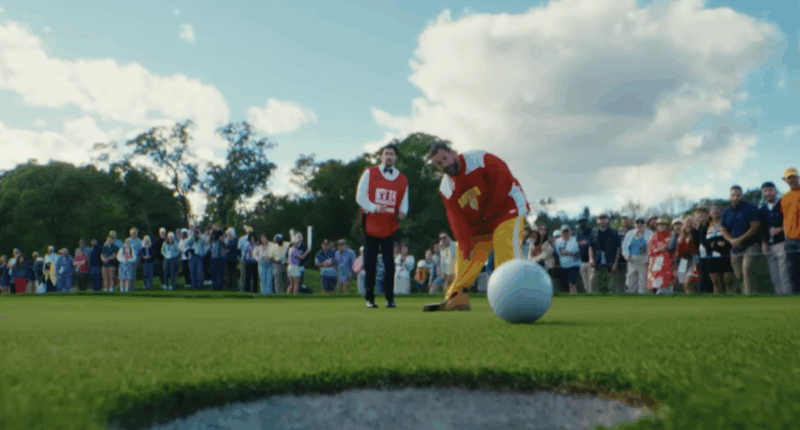When my wife suggested we watch Happy Gilmore 2, Adam Sandler’s self-written and produced reboot of the classic 1996 golf comedy, released in late July on Netflix, I was skeptical.
How does one make a sequel to a ridiculous coming-of-age story? Make Happy Gilmore listless after he already won the PGA championship, so that he must rise from obscurity again? Answer: yes. But beneath the onslaught of celebrity cameos — including the Kansas City Chiefs’ Travis Kelce, pop singer Bad Bunny (Gilmore’s caddy!), and many PGA golfers — a plot line that asks audiences to expel rather than merely suspend their disbelief, and the gratuitously silly scenes that populate the film from start to finish, the movie is shockingly profound and profoundly conservative.
The movie’s core messages are the importance of family, the meaninglessness of hedonism, marriage’s eternal nature, the defense of tradition, the reality of gender roles, and the integrity of the human body. These are provocative and courageous messages to bring audiences (and leftist movie critics) in 2025.
At the movie’s outset, Gilmore explains that since defeating sleazeball and jacket-stealer Shooter McGavin (Christopher McDonald) in the 1996 Happy Gilmore, he won a string of major championships that roughly parallels Tiger Woods’ real-life career: complete dominance of the 2000s after dramatically increasing the sport’s popularity in the late ’90s. Gilmore and Virginia Venit (Julie Bowen) married after their romance in the original, having five children. But after Virginia’s tragic death, Gilmore gives up golf. Without purpose, he slides into depression, alcoholism, poverty, and obscurity. He lives in a squalid house with his daughter and “Uncle John” Daly, the real-life golfer whose role as a garage-living mooch parodies his own messy personal life.
But then Gilmore’s elegant daughter Vienna (Sunny Sandler) gets accepted into a ludicrously expensive Parisian dance school (any movie from 2020 would have had one of the boys go to dance school in a craven bow to woke gender ideology, but Gilmore’s boys in this movie are extremely masculine, perhaps even annoyingly so). In a dream, Gilmore’s late wife exhorts him to resume golf to support Vienna’s ambitions. Thus, Gilmore restarts his career and battles his alcoholism, a movie-long struggle. The not-so-subtle lesson is that family obligations beat even self-interest in motivating men to excellence, while purposelessness is a choice no matter what prior suffering we use to justify it. Did Jordan Peterson co-write this thing?
Notably, Gilmore never flirts with anyone, let alone considers remarriage. Instead, he regularly talks with his late wife and recalls her wisdom in difficult moments. One of the last and most touching scenes is Gilmore seeing a vision of Virginia in heaven, along with Abraham Lincoln, Chubbs Peterson (Carl Weathers), and the alligator Gilmore killed in the original. In an America of checkout-line celebrity divorce gossip magazines and third-generation no-fault divorces, the overtly traditionalist message in a world-famous golfer remaining loyal to his wife even after her death is harder to miss than a one-foot putt.
Gilmore finds himself reentering the PGA as it faces competition from upstart “Maxi golf,” a new league that promises to “revolutionize golf” by making it rowdier, shorter, faster-paced, and more like American Ninja Warrior than the Masters — probably an allusion to the real-life LIV Golf challenge to the PGA. Tech and energy drink CEO Frank Manatee (Benny Safdie), who imitates Sam Bankman-Fried in both appearance and deceitfulness, heads the new league.
A younger Gilmore, angsty and unaccustomed to traditional golf’s stuffy formality, might have been drawn to Maxi. Indeed, Manatee tells Gilmore that he took inspiration from the way Gilmore changed the sport in the ’90s while inviting him to join Maxi.
But the new Happy Gilmore venerates tradition. In one of the most memorable lines of the film, Gilmore refuses Manatee’s offer as follows: “My wife liked the way golf was played before, and she was usually right about everything.” Thereafter, Gilmore plays alongside good ol’ boys, including Rory McIlroy, Scottie Scheffler, and Brooks Koepka, to defend the “true, good, and beautiful” elements of “regular golf” from someone too inhuman to comprehend their value. Edmund Burke would smile.
Manatee’s grotesque main innovation is severing the hip ligaments of golfers to increase backswing length, which allows them to drive further. Gilmore abhors this change to the God-given design of human beings for commercial enhancement, and even Shooter McGavin changes sides upon realizing how Manatee modifies his golfers.
This detail also recalls the episode in Genesis 32:23-32 in which God struck Jacob’s hip socket during a wrestling match, which led to a Jewish prohibition on eating hip meat from animals. The Jewish Sandler may have included this plot device to imply that some modern biotech entrepreneurs see themselves as gods (correct!). In a world increasingly commoditizing human life, through things like surrogacy and IVF’s destruction of “unwanted embryos,” and disrespecting God’s design of our bodies, this badly needed rebuke rings loud and clear.
The movie’s whiplash-inducing plot and occasional diversions into the absurd, such as a graveyard fight scene between Gilmore and McGavin that added little to the movie, are par for the Adam Sandler comedy film course. But Happy Gilmore 2’s overall comedic and nostalgic value are birdies, while its moral message is a timely hole in one.
Nathan Richendollar is a 2019 summa cum laude graduate of Economics and Politics from Washington and Lee University in Lexington, Virginia. His work has also appeared in the Daily Caller, Foundation for Economic Education, Live Action, and the American Spectator. He lives in Southwest Missouri and works in the financial sector.









